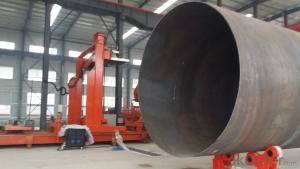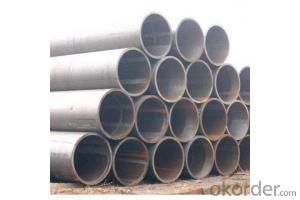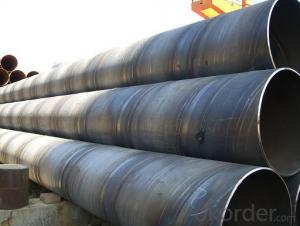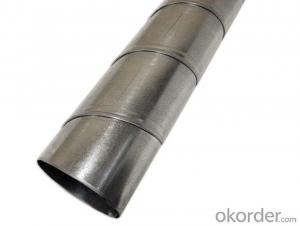48'' Carbon Steel SSAW Welded Pipe API/ASTM/JIS/DIN
- Loading Port:
- Tianjin
- Payment Terms:
- TT or LC
- Min Order Qty:
- 5 m.t
- Supply Capability:
- 300 m.t/month
OKorder Service Pledge
OKorder Financial Service
You Might Also Like
Product Description:
48'' Carbon Steel Welded Pipe API / ASTM / JIS / DIN
OKorder is offering high quality 48’’ Carbon Steel Welded Pipe API / ASTM / JIS / DIN at great prices with worldwide shipping. Our supplier is a world-class manufacturer of carbon steel. Our pipes and steel products are utilized the world over, with OKorder annually supplying a full range of products to European, North American and Asian markets.
Our 48’’ Carbon Steel Welded Pipe API / ASTM / JIS / DIN is ideal for:
Oil
Fuel gas
Natural gas
Water pipes
Thermal electrical pipe
Steel structure engineering
Not only is OKorder's 48’’ Carbon Steel Welded Pipe API / ASTM / JIS / DIN of the highest quality and reliability, we are able to quickly ship orders within 20 days of receiving a deposit or original L/C.
Main features of our 48’’ Carbon Steel Welded Pipe API / ASTM / JIS / DIN
· Corrosion resistance
· Rapid shipping
· Customizable
Specifications:
Material: Q235, Q345, L245, L290, L360, L415, L450, L485, GrB, X42, 46, X52, X56, X60, X65, X70, X80, X100
Standard: SY / T5037-2000, GB / T9711-2011, API Spec 5L PSL1 / PSL2, ASTM A252 \ A53, ISO3183, DIN17172, EN10217, JIS G3457, AWWA C200, ASTM A139, ASTM A671, ASTM A672
Wall Thickness: 3.0mm – 30mm
Outer Diameter: 168mm – 3020mm
Length: 5m – 12m (as per customer request)
Corrosion Resistance: DIN30670, DIN30671, AWWAC210, AWWA C203, SY/T0413-2002, SY/T0414-2002
Q195-q345 Material Steel Pipe's Materials
Elements | Chemical Compsition% | Mechanical Property | ||||||
C% | Mn% | S% | P% | Si% | Yield Point (Mpa) | Tensile Strength(Mpa) | Elongation | |
Q195 | 0.06-0.12 | 0.25-0.50 | <0.050< span=""> | <0.045< span=""> | <0.030< span=""> | >195 | 315-430 | 32-33 |
Q215 | 0.09-0.15 | 0.25-0.55 | <0.05< span=""> | <0.045< span=""> | <0.030< span=""> | >215 | 335-450 | 26-31 |
Q235 | 0.12-0.20 | 0.30-0.70 | <0.045< span=""> | <0.045< span=""> | <0.030< span=""> | >235 | 375-500 | 24-26 |
Q345 | <0.20< span=""> | 1.0-1.6 | <0.040< span=""> | <0.040< span=""> | <0.55< span=""> | >345 | 470-630 | 21-22 |
Packaging & Delivery
Packaging Detail: | Normal exporting packing,in container or bulk vessel or as per clients' request |
Delivery Detail: | 2 months after confimed contract |
FAQ:
Q1: Why buy Materials & Equipment from OKorder.com?
A: All products offered byOKorder.com are carefully selected from China's most reliable manufacturing enterprises. Through its ISO certifications, OKorder.com adheres to the highest standards and a commitment to supply chain safety and customer satisfaction.
Q2: How do we guarantee the quality of our products?
A: We have established an advanced quality management system which conducts strict quality tests at every step, from raw materials to the final product. At the same time, we provide extensive follow-up service assurances as required.
- Q: What is the average cost of steel pipes?
- The average cost of steel pipes can vary depending on several factors such as the size, grade, and quantity of the pipes needed, as well as the current market conditions. Generally, the cost of steel pipes ranges from $500 to $1500 per ton. However, it is important to note that this is a rough estimate, and prices can fluctuate based on factors like demand, location, and quality. It is recommended to reach out to suppliers or manufacturers for more accurate pricing information based on specific project requirements.
- Q: The difference between 12Cr1MoVG alloy steel tube and 15CrMo
- 15CrMo is a steel Pearlite Heat-resistant steel, has high heat resistance at high temperature (b = 440MPa) and antioxidant activity, and has certain ability of anti hydrogen corrosion. Because of the high content of Cr, C and other alloy elements in steel, the tendency of hardening of steel is obvious, and the weldability is poor.
- Q: Heating system DN40 and DN32 welded steel pipe how to connect?
- As for the flange connection: low pressure pipeline is generally not used in this way, can be divided into threaded flanges and flange welding flange, and the flange connecting pipes of different diameters, only the welded flange to diameter, said in a low pressure pipeline which has low pressure pipe connection make an unnecessary move, this is not much, but there are also people with non the standard flange for connecting different pipe diameter, which is not consistent with the technical specification!
- Q: What is the weight of hot galvanized steel tubes? DN150 4mm wall thickness
- DN150 4mm wall thickness welded steel pipe theoretical weight is 16.21kg/m, galvanized steel pipe should be multiplied by the weight coefficient after galvanizing, C, DN150, wall thickness of 4mm, C=1.032, DN150, theoretical weight and wall thickness of 4mm galvanized steel is 1.02*16.21=16.7287kg/m = 16.73kg/m.
- Q: Can seamless steel pipe and ordinary steel pipe be welded?
- Seamless steel tube branch and seamed two, seamed steel pipe welding is formed, all two can be welded together, if you do not allow the use of seam tube cannot connect.
- Q: How are steel pipes classified according to their use?
- Steel pipes are classified according to their use based on factors such as their diameter, wall thickness, and the intended application.
- Q: How do you measure the thickness of steel pipes?
- One common method to measure the thickness of steel pipes is to use a specialized tool called a pipe thickness gauge. This device consists of a small, handheld instrument with a probe that is inserted into the pipe. By applying pressure to the probe, the gauge can accurately determine the thickness of the pipe's wall. Additionally, ultrasonic testing can also be employed to measure the thickness by sending sound waves through the pipe and analyzing the reflections.
- Q: How are steel pipes used in the construction of solar power plants?
- Steel pipes are commonly used in the construction of solar power plants for various purposes. They are primarily utilized for the installation of solar panel mounting structures, which require sturdy and reliable support systems. Steel pipes are also used for the construction of infrastructure such as frames, racks, and supports for the solar panels. Additionally, they are employed in the installation of water and coolant systems, as well as for the transmission of fluids and gases within the plant. Overall, steel pipes play a crucial role in providing structural integrity and efficient functionality to solar power plants.
- Q: What is the difference between black steel pipe and galvanized steel pipe?
- The main difference between black steel pipe and galvanized steel pipe lies in their coating. Black steel pipe is untreated and has a dark, matte appearance, while galvanized steel pipe is coated with a layer of zinc to prevent rusting and has a silver, shiny appearance. This coating makes galvanized steel pipes more durable and suitable for outdoor use, while black steel pipes are commonly used for indoor plumbing and gas lines.
- Q: What is the typical lifespan of steel pipes?
- The lifespan of steel pipes can differ based on several factors, including the steel quality, environmental conditions, and pipe maintenance and usage. On average, steel pipes typically last between 50 and 100 years. However, by installing them correctly, conducting regular inspections, and maintaining them appropriately, steel pipes can often surpass this lifespan and offer dependable service for many decades. It is worth noting that corrosion, erosion, and external damage can affect the longevity of steel pipes. Therefore, it is essential to implement preventive measures and carry out necessary repairs to guarantee their durability.
Send your message to us
48'' Carbon Steel SSAW Welded Pipe API/ASTM/JIS/DIN
- Loading Port:
- Tianjin
- Payment Terms:
- TT or LC
- Min Order Qty:
- 5 m.t
- Supply Capability:
- 300 m.t/month
OKorder Service Pledge
OKorder Financial Service
Similar products
Hot products
Hot Searches
Related keywords
























